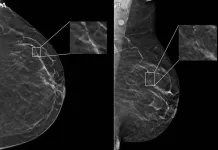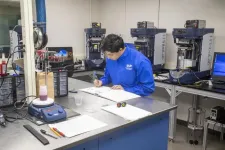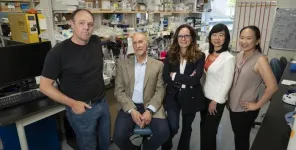(Press-News.org) OAK BROOK, Ill. – In a study of nearly 5,000 screening mammograms interpreted by an FDA-approved AI algorithm, patient characteristics such as race and age influenced false positive results. The study’s results were published today in Radiology, a journal of the Radiological Society of North America (RSNA).
“AI has become a resource for radiologists to improve their efficiency and accuracy in reading screening mammograms while mitigating reader burnout,” said Derek L. Nguyen, M.D., assistant professor at Duke University in Durham, North Carolina. “However, the impact of patient characteristics on AI performance has not been well studied.”
Dr. Nguyen said while preliminary data suggests that AI algorithms applied to screening mammography exams may improve radiologists’ diagnostic performance for breast cancer detection and reduce interpretation time, there are some aspects of AI to be aware of.
“There are few demographically diverse databases for AI algorithm training, and the FDA does not require diverse datasets for validation,” he said. “Because of the differences among patient populations, it’s important to investigate whether AI software can accommodate and perform at the same level for different patient ages, races and ethnicities.”
In the retrospective study, researchers identified patients with negative (no evidence of cancer) digital breast tomosynthesis screening examinations performed at Duke University Medical Center between 2016 and 2019. All patients were followed for a two-year period after the screening mammograms, and no patients were diagnosed with a breast malignancy.
The researchers randomly selected a subset of this group consisting of 4,855 patients (median age 54 years) broadly distributed across four ethnic/racial groups. The subset included 1,316 (27%) white, 1,261 (26%) Black, 1,351 (28%) Asian, and 927 (19%) Hispanic patients.
A commercially available AI algorithm interpreted each exam in the subset of mammograms, generating both a case score (or certainty of malignancy) and a risk score (or one-year subsequent malignancy risk).
“Our goal was to evaluate whether an AI algorithm’s performance was uniform across age, breast density types and different patient race/ethnicities,” Dr. Nguyen said.
Given all mammograms in the study were negative for the presence of cancer, anything flagged as suspicious by the algorithm was considered a false positive result. False positive case scores were significantly more likely in Black and older patients (71-80 years) and less likely in Asian patients and younger patients (41-50 years) compared to white patients and women between the ages of 51 and 60.
“This study is important because it highlights that any AI software purchased by a healthcare institution may not perform equally across all patient ages, races/ethnicities and breast densities,” Dr. Nguyen said. “Moving forward, I think AI software upgrades should focus on ensuring demographic diversity.”
Dr. Nguyen said healthcare institutions should understand the patient population they serve before purchasing an AI algorithm for screening mammogram interpretation and ask vendors about their algorithm training.
“Having a baseline knowledge of your institution’s demographics and asking the vendor about the ethnic and age diversity of their training data will help you understand the limitations you’ll face in clinical practice,” he said.
###
“Patient Characteristics Impact Performance of AI Algorithm in Interpreting Negative Screening Digital Breast Tomosynthesis Studies.” Collaborating with Dr. Nguyen were Yinhao Ren, Ph.D., Tyler M. Jones, B.S., Samantha M. Thomas, M.S., Joseph Y. Lo, Ph.D., and Lars J. Grimm, M.D., M.S.
Radiology is edited by Linda Moy, M.D., New York University, New York, N.Y., and owned and published by the Radiological Society of North America, Inc. (https://pubs.rsna.org/journal/radiology)
RSNA is an association of radiologists, radiation oncologists, medical physicists and related scientists promoting excellence in patient care and health care delivery through education, research and technologic innovation. The Society is based in Oak Brook, Illinois. (RSNA.org)
For patient-friendly information on breast cancer screening, visit RadiologyInfo.org.
END
SAN ANTONIO — May 21, 2024 —As a leader in fuels and lubricants research, Southwest Research Institute is home to a world-class tribology laboratory and expert staff that are developing advanced techniques and technology to study wear, friction and lubrication. SwRI tribologists will share their expertise at the 2024 Society of Tribologists and Lubrication Engineers (STLE) Annual Meeting May 19-23 in Minneapolis.
The STLE Annual Meeting and Exhibition invites members of the lubricant industry ...
Hope for a cure for visceral leishmaniasis, an often fatal infectious disease
A discovery by Simona Stäger’s team could help come up with a treatment to the most serious form of leishmaniasis.
Leishmaniasis is a tropical disease affecting a growing number of people worldwide. Each year, between 700,000 and 1 million new cases are reported. Caused by a protozoan parasite of the genus Leishmania, which is transmitted to humans by the simple bite of a sand fly, leishmaniasis comprises three clinical forms, of which the visceral ...
Generative models like diffusion models are one of the most important recent developments in Machine Learning (ML), with models as Stable Diffusion and Dall.e revolutionizing the field of image generation. These models are able to produce high quality images based on some text description. “Our new model for programming quantum computers does the same but, instead of generating images, it generates quantum circuits based on the text description of the quantum operation to be performed”, explains Gorka Muñoz-Gil from the Department of Theoretical Physics of ...
New MBARI research on a field of pockmarks—large, circular depressions on the seafloor—offshore of Central California has revealed that powerful sediment flows, not methane gas eruptions, maintain these prehistoric formations. A team of researchers from MBARI, the United States Geological Survey (USGS), and Stanford University published their findings today in the Journal of Geophysical Research: Earth Surface. This work provides important information to guide decision-making about responsible use and management of the seafloor off California, including site assessments for the development of offshore wind farms.
The Sur Pockmark Field—an area about the size ...
New York, NY [May 21, 2024]—Generative artificial intelligence (AI), such as GPT-4, can help predict whether an emergency room patient needs to be admitted to the hospital even with only minimal training on a limited number of records, according to investigators at the Icahn School of Medicine at Mount Sinai. Details of the research were published in the May 21 online issue of the Journal of the American Medical Informatics Association (JAMIA/DOI: 10.1093/jamia/ocae103).
In the retrospective study, the researchers analyzed records from seven Mount Sinai Health System hospitals, using both structured data, such as vital signs, ...
Highlights:
Periodontitis is linked to tooth loss and other health concerns.
Past studies suggest that green tea products can act against P. gingivalis, which causes periodontitis.
In a new study, researchers tested matcha extract, made from green tea, against the pathogen.
Lab studies suggest matcha inhibits the growth of the bacteria.
A clinical trial showed that matcha mouthwash inhibited P. gingivalis populations in saliva.
Washington, D.C.—Periodontitis is an inflammatory gum disease driven by bacterial infection and left untreated it can lead to complications including tooth loss. ...
WARSAW, POLAND [May 21, 2024] — The National Comprehensive Cancer Network® (NCCN®)—a global nonprofit responsible for leading cancer treatment guidelines—is taking part in two events in Warsaw focused on advancing cancer care and highlighting the Poland-US bilateral achievements in health care from May 21-22, 2024. The meetings will be organized by Maria Sklodowska-Curie National Research Institute of Oncology, the Polish Oncological Society, and the Alliance for Innovation. ...
LOS ANGELES — City of Hope®, one of the largest cancer research and treatment organizations in the United States, has been awarded $5.4 million from the California Institute for Regenerative Medicine (CIRM) to build and fund a stem cell research laboratory on its Duarte, California, campus that will further expand its scientific capabilities.
The mission of the unique Stem Cell-Based Disease Modeling Laboratory is two-fold. First, it will advance stem cell-based disease modeling to spur innovation in regenerative medicine. The laboratory leverages City of Hope’s infrastructure ...
Thousands of top nutrition experts will gather next month for a dynamic program of research announcements, policy discussions and award lectures at NUTRITION 2024, the annual flagship meeting of the American Society for Nutrition. Reporters and bloggers are invited to apply for a complimentary press pass to attend the meeting in Chicago from June 29–July 2.
Explore the meeting schedule and register for a press pass to attend.
Hot topics to be explored at NUTRITION 2024 include:
Diet and cancer ...
A World Health Organization Essential Medicine, ketamine is widely used at varying doses for sedation, pain control, general anesthesia and as a therapy for treatment-resistant depression. While scientists know its target in brain cells and have observed how it affects brain-wide activity, they haven’t known entirely how the two are connected. A new study by a research team spanning four Boston-area institutions uses computational modeling of previously unappreciated physiological details to fill that gap and offer new insights into how ketamine works.
“This modeling work has helped decipher likely mechanisms through which ...









